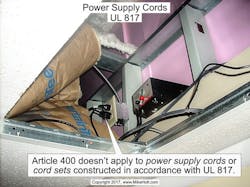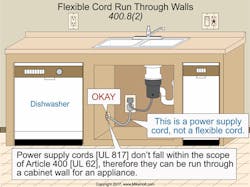The NEC doesn’t consider flexible cords to be wiring methods like those defined in Chapter 3. They fill a different niche; therefore, they are in a different Chapter.
Much of our infrastructure and industry simply would not run without flexible cords and cables. You would not, for example, be able to take an elevator ride or operate a hoist without them. Many types of lighting installations also rely on them, as does a wide range of equipment.
Article 400 covers the general requirements, applications, and construction specifications for flexible cords and cables. But Art. 400 doesn’t apply to “power supply cords” or “cord sets” constructed in accordance with UL 817 (Photo 1).
Flexible cords and cables are designed and built to be safe, but only when you use one (and fittings) identified for the application. For example, use cords listed for a wet location if you’re using them outdoors. The jacket material is tested to maintain its insulation properties and other characteristics in environments for which the cord (or cable) has been listed.
To know what works for which application, look at Table 400.4 (Photo 2). Tables 400.5(A)(1) and 400.5(A)(2) are also important tables; turn to these when looking for the ampacity of flexible cords and cables.
Ampacity
Table 400.5(A)(1) lists the allowable ampacity for copper conductors in flexible cords and cables. Table 400.5(A)(2) lists the allowable ampacity for copper conductors in flexible cords and cables with not more than three current-carrying conductors at an ambient temperature of 86°F.
Where the number of current-carrying conductors in a cable or raceway exceeds three, you must adjust the allowable ampacity of each conductor per the following multipliers:
- four to six conductors (0.80)
- seven to nine conductors (0.70)
- 10 to 20 conductors (0.50)
If the ambient temperature is other than 86°F, the flexible cord or flexible cable ampacity, as listed in Table 400.5(A)(1) or 400.5(A)(2), must be adjusted by using the ambient temperature correction factors listed in Table 310.15(B)(2)(a).
Temperature ratings for flexible cords and cables aren’t contained in the NEC, but testing laboratory listing standards state that flexible cords and cables are rated for 60°C unless marked otherwise.
Where can you use these?
If you look in Chapter 3, you’ll notice that many of the Articles have a subsection 10 titled “Uses Permitted.” We noted earlier that the NEC doesn’t consider flexible cords and cables to be a wiring method in the Chapter 3 sense. Article 400 differs in structure from the wiring method Articles, too. In this case, you’ll find “Uses Permitted” in subsection 7.
- Flexible cords and cables within the scope of this Article can be used for the following applications [400.7(A)]:
- Pendants [210.50(A) and 314.23(H)]. Note that only cords identified for use as pendants in Table 400.4 may be used for pendants.
- Wiring of luminaires [410.24(A) and 410.62(B)].
- Connection of portable luminaires, portable and mobile signs, or appliances [422.16].
- Elevator cables.
- Wiring of cranes and hoists.
- Connection of utilization equipment to facilitate frequent interchange [422.16] (Fig. 1).
- Prevention of the transmission of noise or vibration [422.16].
- Appliances where the fastening means and mechanical connections are specifically designed to permit ready removal for maintenance and repair, and the appliance is intended or identified for flexible cord connections [422.16].
- Connection of moving parts.
Flexible cords and cables are permitted for fixed permanent wiring by 501.10(A)(2) and (B)(2), 501.140, 502.10, 052.140, 503.10, 503.140, 550.10(B), 553.7(B), and 555.13(A)(2).
Attachment plugs
Attachment plugs are required for flexible cords used in any of the following applications [400.7(B)]:
- Portable luminaires, portable and mobile signs, or appliances [400.7(A)(3)].
- Stationary equipment to facilitate its frequent interchange [400.7(A)(6) and 422.16].
- Appliances specifically designed to permit ready removal for maintenance and repair, and identified for flexible cord connection [400.7(A)(8)].
An attachment plug can serve as the disconnecting means for stationary appliances [422.33] and room air conditioners [440.63].
Don’t use here
Many of the Chapter 3 Articles have a subsection 12, Uses Not Permitted. In Article 400, that’s covered in subsection 8.
Unless specifically permitted in 400.7, flexible cords must not be:
- Used as a substitute for the fixed wiring of a structure.
- Run through holes in walls, structural ceilings, suspended or dropped ceilings, or floors.
- Run through doorways, windows, or similar openings.
- Attached to building surfaces.
- Concealed by walls, floors, or ceilings, or located above suspended or dropped ceilings.
- Installed in raceways, except as permitted by 400.14 for industrial establishments where the conditions of maintenance and supervision ensure that only qualified persons will service the installation.
- Subject to physical damage. Even cords listed as “extra-hard usage” must not be used where subject to physical damage.
The above prohibitions are best understood with some additional explanation.
Article 400 requirements apply only to flexible cords [UL 62]. Power supply cords [UL 817] don’t fall within the scope of Art. 400, so you can run a power supply cord through a cabinet wall for an appliance (Fig. 2). You can also run a power supply cord through, or locate it above, a suspended ceiling.
You can run flexible cords under a raised floor (with removable panels) not used for environmental air, because this area isn’t considered a concealed space. See the definition of “Exposed” in Art. 100.
The physical damage caution is also repeated all through Chapter 3. It really applies no matter what wiring method or cord or cable you use. It’s not the case that if there’s exposure to physical damage you just use something heavier and “problem solved.” That is a common error with (for example) rigid metal conduit (RMC) [Article 344], as if simply choosing this is good enough and never mind that it’s being installed such that being crushed by the massive counterweight on a lift truck is inevitable.
When installing any electrical equipment, wiring method, cord, or cable, always assess the situation for the likely hazards. Then, determine which of the many options at your disposal can mitigate or eliminate the threat of physical damage. The options include everything from changing the routing to installing protective barriers.
For example, what if the flexible cord supplies a drill press and just moving the press a few feet allows running the cord with no danger of physical damage? There are also many protective products on the market, so for a few dollars you can eliminate the risk with a very simple solution. These products can typically serve the dual function of eliminating the tripping hazard a cord or cable can pose to people. That dual function is especially helpful in high-traffic or high-stress areas, such as construction sites or operating rooms.
Can’t take the tension
Install flexible cords and cables so as not to transmit tension to the conductor terminals [400.10]. You can accomplish this by knotting the cord, winding the cord with tape, or by using support or strain relief fittings. But when critical health and economic activities depend upon flexible cord-supplied equipment, the best method is a factory-made, stress-relieving, listed device — not an old-timer’s knot.
Also, make sure to use bushings or fittings to protect these cords where they pass through holes in covers, outlet boxes, or similar enclosures [400.14].
In industrial establishments where the conditions of maintenance and supervision ensure that only qualified persons will service the installation, flexible cords or cables not exceeding 50 ft can be installed in aboveground raceways.
Equipment grounding conductor identification
A conductor intended for use as an equipment grounding conductor must have a continuous green color or a continuous identifying marker distinguishing it from the other conductor(s) [400.23]. Conductors with green insulation — or green with one or more yellow stripes — must not be used for an ungrounded or neutral conductor [250.119].
Pay close attention. These cords and cables are flexible, but your attention to the Code requirements can’t be. Perhaps the most important step you can take is to ensure you’re installing the right cord or cable for the application. It’s important to remember the solution isn’t always obvious.
For example, Table 400.4 provides three different trade names for heater cords and each has its own entry in the Table. If that seems a bit confusing, the Table provides four trade name entries for elevator cables. The use you can make of a given cord or cable depends upon such factors as type, size, outer covering, and voltage rating. These are accounted for in the Table.
Holt is the owner of Mike Holt Enterprises, Inc. in Leesburg, Fla. He can be reached at www.mikeholt.com.
About the Author

Mike Holt
Mike Holt is the owner of Mike Holt Enterprises (www.MikeHolt.com), one of the largest electrical publishers in the United States. He earned a master's degree in the Business Administration Program (MBA) from the University of Miami. He earned his reputation as a National Electrical Code (NEC) expert by working his way up through the electrical trade. Formally a construction editor for two different trade publications, Mike started his career as an apprentice electrician and eventually became a master electrician, an electrical inspector, a contractor, and an educator. Mike has taught more than 1,000 classes on 30 different electrical-related subjects — ranging from alarm installations to exam preparation and voltage drop calculations. He continues to produce seminars, videos, books, and online training for the trade as well as contribute monthly Code content to EC&M magazine.




